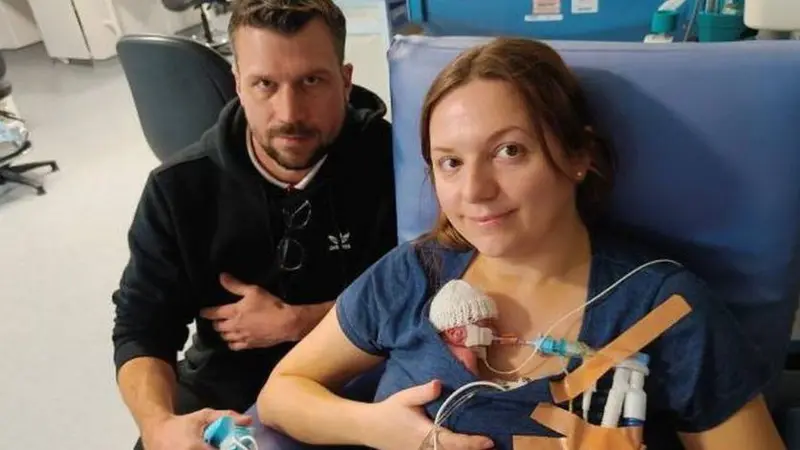
The parents of a baby named Robyn, who was born very tiny at just 11 ounces (328 grams), have finally brought her home after 18 months in the hospital.
Robyn was born five months early in March 2023 at Grange Hospital in Cwmbran, Torfaen, and she still needs special care all the time. Her parents, Chantelle (34) and Daniel (38) from Malpas, Newport, are raising money for her treatment. Chantelle said, “It’s like a dream come true to have Robyn home.”
Robyn was born at just 23 weeks and 2 days and was so tiny that she could fit in the palm of a hand. To keep her organs warm while she grew, she was kept in a sandwich bag.
After six months in the hospital, she spent another seven months in the pediatric intensive care unit at Noah’s Ark Children’s Hospital in Cardiff. She then returned to Grange Hospital until she was finally discharged in September.
Chantelle, who works part-time as an accountant, said, “It’s just so nice to do normal family things… and just all be together under one roof.”
Daniel, a self-employed bricklayer, mentioned that it’s much less chaotic at home now. He has had to cut back on work to focus on taking care of his daughter.

Robyn gets oxygen and nutrition through tubes in her nose and mouth, and her vital signs are watched all the time. She takes 30 doses of medication each day.
Her mom, Chantelle, explained, “She can’t cough, so we have to suction her mouth and nose throughout the day when she needs it.”
Daniel described Robyn as doing well and enjoying the “peace” of being at home. He added that they do a lot of physical therapy and play with her to help her senses.

Chantelle said it was tough to bond with Robyn in the busy hospital ward, with doctors and nurses always coming in and out.
“All you can do is sit next to her and watch,” she explained, “keeping an eye on the numbers on the screen and hoping she will be okay.”
“When Robyn was born, we weren’t sure if she would survive.
“As time went on, she grew bigger and stronger, but she still faced many problems. It became clear that her brain damage would have a big impact on her.”
‘We know nothing is impossible’
“We didn’t learn about her brain damage until about six months after she was born,” Daniel said.
“You have all these plans for how life will be, and then everything changes,” he added.
“But we try to stay positive.
“We know that nothing is impossible for Robyn because she has been told so many times that she wouldn’t be able to do things or even survive, but she keeps proving everyone wrong.
“She’s full of surprises, and I believe she will create her own story.”
George W. Bush celebrates the arrival of his grandson, named in tribute to his great-grandfathers
Former U.S. President George W. Bush, now 78, joyfully announced the birth of his new grandson on social media.
On Tuesday, August 6, Bush shared a heartfelt photo on Instagram to celebrate the arrival of his daughter Barbara Pierce Bush’s second child with husband Craig Coyne. The couple, who already have a 2-year-old daughter, Cora Georgia, welcomed their son, Edward Finn, just days earlier.

In the sweet photo, Barbara and Craig are seen in a hospital bed, tenderly holding their newborn as they gaze at him with joy. “Welcome to the world, Edward Finn Coyne. @laurawbush and I are proud grandparents of our newest blessing, born on August 4 and lovingly named in honor of his great-grandfathers,” Bush captioned the post. He added, “Congratulations to Barbara, Craig, and big sister Cora Georgia.”
Barbara’s twin sister, Jenna Bush Hager, was the first to share the happy news on Monday, August 5. Jenna, co-anchor of the Today show, expressed her excitement about becoming an aunt again on Instagram, writing, “My sissy had a little mister and I fell madly in love with Edward Finn! ❤️💗👼.”

Jenna’s post included a series of photos from the family’s special moments after Edward’s birth. In one, Jenna is seen feeding her new nephew, while another shows Barbara cradling Edward with Jenna admiring the scene. A third photo captures Edward peacefully resting in his mother’s arms.
Though Jenna didn’t share specific birth details, one of the photos shows Edward wearing a hat from NYU Langone Health, suggesting Barbara may have given birth at the prestigious New York City hospital.
This is not the first time George W. Bush and his wife, Laura, have expressed their joy over becoming grandparents. When Barbara and Craig welcomed their daughter Cora in September 2021, the Bushes released a statement to announce the news.
“With full hearts, @laurawbush and I are delighted to announce the birth of our new granddaughter. Barbara gave birth to Cora Georgia Coyne on September 27, 2021, in Maine – not far from our family home where Barbara and Craig were married,” the couple shared at the time. “Cora is healthy and adorable, and we are proud and grateful.”
Now, with the addition of Edward Finn, the Bush family has even more to celebrate!



Leave a Reply